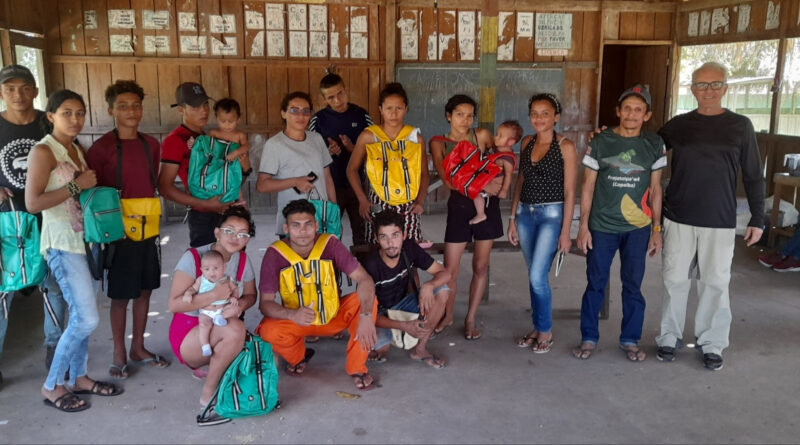Published on August 16, 2024 by Vanguarda Amazonense.

The Takuya village of the Xipaya Indigenous Land in the Xingu has inaugurated a new fabric drying machine, the result of a partnership between LIRA/IPÊ – Legado Integrado da Região Amazônica (Integrated Legacy of the Amazon Region), IPÊ – Instituto de Pesquisas Ecológicas (Ecological Research Institute), the Aldeia Tukaya Indigenous Association – AITEX, Mercur, a Brazilian innovation and social responsibility company, and Bossapack, which produces sustainable handmade backpacks and bags. The vulcanizer represents a technological advance that will bring many benefits to the local community.
Made of aluminum and thermoplastic plastic, the vulcanizer speeds up the drying of encauched fabrics (produced by combining an ancient indigenous technique that dehydrates latex with modern industrial scientific technology), using mainly solar energy. First, the natural latex extracted from rubber trees is applied to the organic cotton. This latex-coated cotton then undergoes dehydration, a method that dries and hardens the latex, making the fabric flexible, durable and water-resistant. These resulting fabrics are called encauchados and are ideal for making products such as sustainable backpacks and bags, as they are strong and resistant to weather conditions.
The vulcanizer’s oven reduces the drying time from nine days to one. “This increases production capacity and provides more economic stability for the community,” says Fabiana Prado, manager of LIRA/IPÊ. “The arrival of the vulcanizing machine in the Tukaya village exemplifies Amazon 4.0 in action,” says Cláudio Martins, founding partner of Bossapack.
| Economic and social impacts Previously, indigenous people received R$4.25 per liter of latex in its raw form, sold in blocks. With the vulcanizer, the latex is transformed into high quality fabrics, reaching R$ 64 per liter, due to the use of these fabrics in handicraft products.The project involves 30 people, mainly young people aged between 16 and 26, creating job opportunities and developing skills. The inclusion of women in fabric painting promotes social and economic inclusion, offering new sources of income and strengthening their position in the community. |
| The fabrics are painted by women from the community using natural pigments such as annatto. The backpacks produced are durable, water-resistant and sustainable, reflecting the cultural and artistic heritage of the Tukaya village. Each backpack carries a QR code, connecting consumers to the history and production process, valuing the community’s traditions and sustainable practices. |
| Rubber roadsLatexproduction helps conserve the forest. Each rubber road needs 150 hectares of preserved forest around it. In the Tukaya village project, 12 roads were used, resulting in the protection of 1800 hectares of forest. In addition, the harvesting of annatto for natural pigments encourages the maintenance of additional forest areas. “Our idea is to expand the model to other villages, while maintaining sustainability and social inclusion,” says Cláudio. |
| The success of the initiative is due to the support of LIRA/IPÊ and Mercur, through the “Solar Greenhouse Project”, which promotes the sustainable rubber chain in the Amazon, integrating ancestral knowledge in the production of woven fabrics. Bossapack uses these fabrics to create handmade backpacks and bags, selling them in Brazil and abroad. “This project strengthens cultural and environmental conservation, promoting sustainability and the continuity of traditions, taking Brazil to the world,” says Fabiana. LIRA’s role in Amazon conservationFoundedby biologist Fabiana Prado, LIRA/IPÊ is a driving force in Amazon conservation. With an investment of R$46 million over four years, it has collaborated with more than 125 organizations, benefiting 52,000 people and conserving 58 million hectares of forest. It is the largest CSO project of the Amazon Fund and the second largest conservation project in the Amazon. The R$80,000 financing provided by LIRA/IPÊ, through the LIRA Fund, enabled the construction of the greenhouse and workshops in the village, ensuring that the equipment would be owned by the indigenous people. “LIRA’s support has been fundamental in turning this vision into reality, guaranteeing a more prosperous and sustainable future for the indigenous community of the Amazon,” says Cláudio. “The collaboration between tradition and technological innovation makes this project an example of sustainability and inclusion,” says Fabiana. |
| About LIRA LIRA – Legado Integrado da Região Amazônica (Integrated Legacy of the Amazon Region) is an integrative initiative that boosts conservation efforts in the Amazon through three components: 1) The LIRA Fund, which finances socio-environmental projects with traditional peoples and communities; 2) Knowledge Management and Innovation; and 3) Socio-environmental Public Policies. It brings together a network of 125 organizations operating in 5 states with an Amazon biome, through the implementation of 50 projects in 59 protected areas (indigenous lands and conservation units) – promoting biodiversity conservation, the well-being of traditional peoples and communities and climate resilience. Executor: IPÊ – Institute for Ecological Research. Funding Partners: Amazon Fund and Gordon and Betty Moore Foundation. Institutional partners: the National Indian Foundation (FUNAI), the Chico Mendes Institute for Biodiversity Conservation (ICMBio), the Amazonas State Secretariat for the Environment (SEMA-AM) and the Pará State Institute for Forestry and Biodiversity Development (IDEFLOR-Bio). |


